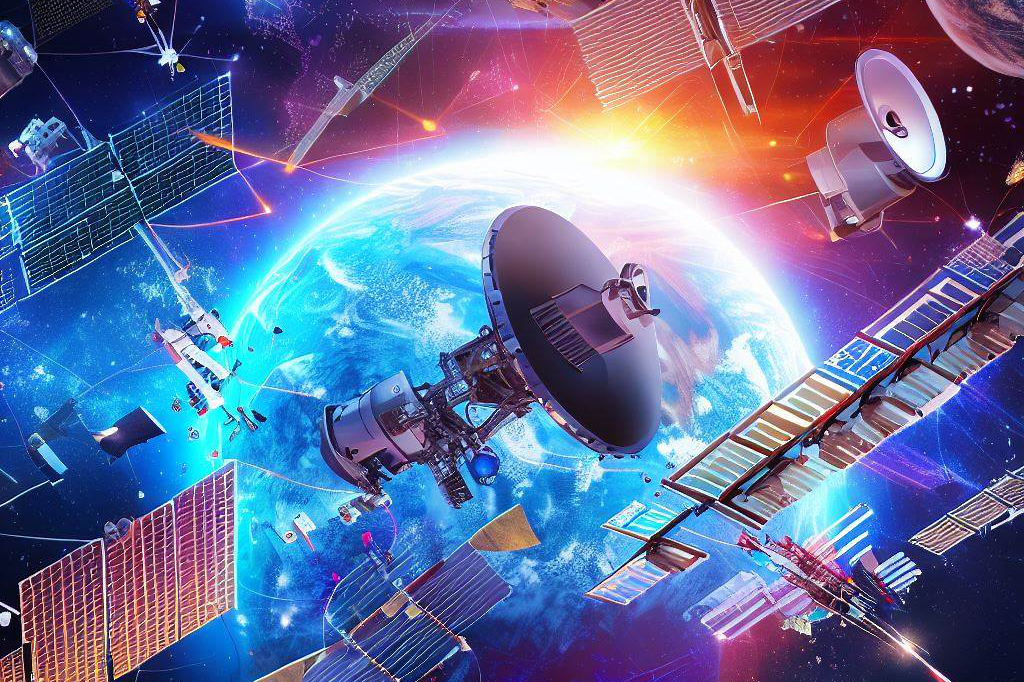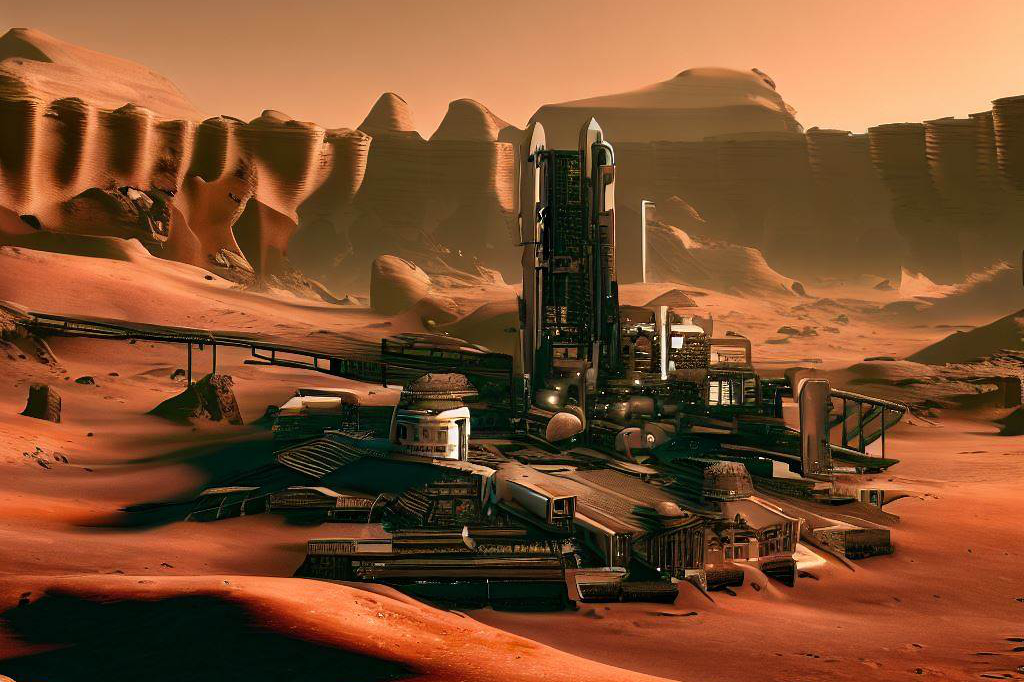Here we shall look to answer: What are the key sectors of the space industry and how do they contribute to the overall economy?
The Space Industry: A Universe of Possibilities
When we think of the space industry, we often imagine astronauts floating in the vast emptiness of outer space or futuristic spaceships zooming through galaxies. But the reality is that the space industry encompasses a wide variety of sectors that play a vital role in our daily lives on Earth.

The space industry is made up of various sectors including:
- launch services,
- satellite manufacturing and operations,
- space tourism,
- space mining,
- and research and development
Each sector contributes to advancements in technology and scientific knowledge while also making significant contributions to the global economy.
The Importance of the Space Industry to the Economy
While some may view investments in the space industry as frivolous or unnecessary, it’s important to recognize their significant impact on our economy. According to a report by Space Foundation, the global space economy was valued at $423.8 billion in 2019 with an average annual growth rate of 4.6% over a decade.
Furthermore, various sectors within the industry provide numerous job opportunities for individuals with diverse backgrounds such as engineers, scientists, mathematicians and more. The technological advancements made within this industry have also led to spinoff technologies that have improved daily life for many people around the world.
In short, it’s clear that investing in this industry has far-reaching benefits beyond just exploring outer space. So let’s take a closer look at some key sectors themselves:
Launch Services Sector
The launch services sector of the space industry is responsible for launching spacecraft and satellites into orbit. This includes everything from designing and building rockets to actually launching them into space. The industry has been dominated by government agencies like NASA and Roscosmos, but in recent years, private companies have entered the market as well.

Major players in the industry
Some of the major players in the launch services sector include
- SpaceX,
- United Launch Alliance (ULA),
- Blue Origin,
- Arianespace,
- and China Aerospace Science and Technology Corporation (CASC)
These companies are all involved in developing rockets that can carry payloads into space. SpaceX has become particularly well-known for its reusable Falcon 9 rocket, which has drastically reduced the cost of launching payloads into space.
Contribution to the economy
The launch services sector is a crucial part of the overall space industry and contributes significantly to the global economy. According to a report by Space Foundation, the global launch market generated $5.6 billion in revenue in 2019 alone. Furthermore, this sector not only contributes monetarily but also helps advance technology as rocket development has sparked advancements that translate directly back down on earth with improvements on propulsion systems or autonomous guidance systems for example.
The use of satellites has become integral to many industries such as telecommunications or mapping, making modern communication possible, reaching even remote areas – but would not be possible without reliable launch options from these private companies that have emerged over recent years. The demand for launches is increasing with more countries desiring access to their own satellite constellations leading to increased competition between these organizations which will lead to further advancements benefiting both space exploration itself as well as Earth-based technologies developed through its research and development programs.
The Satellite Manufacturing and Operations Sector
The satellite manufacturing and operations sector is a crucial part of the space industry. It involves designing, building, testing, launching, and operating satellites that are used for various purposes, including
- communication,
- navigation,
- remote sensing,
- weather forecasting,
- and scientific research.
The sector is driven by both government agencies and private companies that invest heavily in satellite technology.

Types of Satellites Produced and Their Uses
There are several types of satellites produced by this sector with different uses. For instance:
– Communication satellites: used for broadcasting TV signals and internet services.
– Navigation satellites: used for GPS systems that help with location tracking.
– Remote sensing satellites: used to monitor natural resources such as water or detect changes in weather patterns.
– Scientific Research Satellites: used to gather data on topics like climate change or space exploration.
These different types of satellites play a significant role in our daily lives which makes them essential assets to governments worldwide.
Major Players in the Industry
Several major players dominate the satellite manufacturing industry globally. These include
- Airbus Defense & Space (France),
- Lockheed Martin (US),
- Boeing Defense Space & Security (US),
- Thales Alenia Space (France/Italy),
- Northrop Grumman (US)
Airbus Defense & Space (France), Lockheed Martin (US), Boeing Defense Space & Security (US), Thales Alenia Space (France/Italy), Northrop Grumman (US) among others. These companies invest billions of dollars into research and development annually to stay ahead of their competitors in terms of innovation while ensuring quality products.
Contribution to the Economy
The satellite manufacturing industry plays an essential role in boosting economies worldwide through its use in a variety of industries such as telecommunications, and transportation systems management among others. In addition to this indirect contribution by enabling other industries through its technologies; it also has a more direct economic impact through job creation since these firms employ thousands globally.
The Future of Space Travel: The Space Tourism Sector

With the rise of commercial space companies such as Virgin Galactic and SpaceX, space tourism has become a reality. The space tourism sector involves the transportation of paying customers to space for leisure purposes. This industry offers a unique experience that few people have had the opportunity to enjoy.
Virgin Galactic is one of the major players in this industry. They have been working on developing a spacecraft that will take passengers on suborbital flights, offering them several minutes of weightlessness and a breathtaking view of Earth from above.
Blue Origin, owned by Amazon founder Jeff Bezos, is another company that has made significant strides in the field of space tourism with its New Shepard spacecraft. The potential for growth in this industry is huge, with more and more companies investing in research and development to make commercial space travel accessible to the general public.
This sector could generate significant revenue for the overall economy through ticket sales and other related services such as accommodation and transportation for customers. It also has potential implications for scientific research as more people gain access to space and contribute towards advancements in our understanding of our universe.
While still relatively new, the Space Tourism Sector shows signs of tremendous growth with multiple companies vying for top positions within it. In time it could become one of the most profitable sectors within the broader industry, generating billions in revenues annually while providing an unparalleled experience to those who can afford it.
Space Mining Sector: The Future of Resource Extraction
The idea of space mining might still seem like a concept from science fiction movies, but the space mining sector is actually already a reality. The sector involves using advanced technology to extract resources such as water, metals and rare earth elements from asteroids, comets, and other space bodies. These resources are then used for a variety of purposes such as fuel for spacecraft, construction materials for space stations and exploration equipment.

Types of Resources That Can Be Mined From Space
Several types of resources can be mined from space. One of the most important resources is water which can be extracted from asteroids or comets and then turned into rocket fuel through the process of electrolysis.
Other valuable resources include platinum group metals which are used in the manufacture of electronics and medical equipment. Rare earth elements such as europium and yttrium are also found in abundance in space bodies.
Companies Involved in Space Mining
Several companies have already invested heavily into this sector including Deep Space Industries (DSI) and Planetary Resources.
DSI plans to use 3D-printing technology to create spacecraft parts made out of materials that are mined from asteroids.
Planetary Resources has already launched two satellites for testing purposes with an aim to eventually mine asteroids.
Contribution to the Economy
Space mining has enormous potential for generating wealth not just for those involved in its operations but also by creating new industries that support it. It is estimated that a single asteroid can contain trillions of dollars’ worth of minerals, making this sector capable of generating trillions or even quadrillions worth annually once it’s fully established. Additionally, space mining will reduce reliance on terrestrial resource extraction which often causes environmental damage.
While there are several challenges associated with extracting resources from space, including logistics and high costs, the space mining industry has enormous potential. The sector is already attracting a lot of attention from investors and entrepreneurs alike, and it’s only a matter of time before it begins to contribute significantly to the overall economy.
Research and Development Sector
The Search for Innovation in Space

When it comes to the space industry, research and development (R&D) is crucial. The R&D sector in the space industry includes organizations that are dedicated to designing, developing, and testing new technologies for use in space.
This sector is responsible for the evolution of space technology. It’s important to note that this sector involves government agencies like NASA as well as private companies.
The R&D sector has been an essential component of the space industry since its inception. Major players in R&D include NASA, SpaceX, Blue Origin, Boeing, and Lockheed Martin.
These organizations invest billions of dollars each year into researching new technologies such as advanced propulsion systems, materials science innovations, and advanced manufacturing techniques. Advances made by these companies during their research have resulted in significant contributions to technological advancements in other industries beyond just space exploration.
Satellite communication technology has enabled businesses worldwide to connect with customers across borders more efficiently than ever before while GPS technology powers everything from navigation in our cars to precision agriculture on farms. As scientific understanding of zero-gravity environments improves with time spent at the International Space Station (ISS), there is potential for new breakthroughs like disease cures or materials science discoveries that could transform medicine or engineering forever.
Major Players Powering Innovation
NASA’s role in R&D cannot be overstated – funding projects both within its own agency as well as providing grants to outside organizations focused on developing new technologies for use across industries beyond just space exploration.
SpaceX is a privately held company founded by Elon Musk which aims at reducing costs associated with accessing space through reusability of rockets and spacecrafts; their success stories include reusable boosters which have slashed launch costs significantly.
Blue Origin- another company founded by Amazon CEO Jeff Bezos – focuses on developing reusable suborbital vehicles capable of carrying both crew and cargo payloads. Boeing and Lockheed Martin, both major players in R&D, focus on developing technologies for space exploration and satellite manufacturing.
Among notable innovations from these companies are the Hubble Space Telescope and the GPS system. Innovation is the lifeblood of R&D, driving change through new discoveries that benefit humanity as a whole.
The development of new technologies has led to some of the most significant advancements in recent history. The future of space exploration is exciting as more and more organizations invest in R&D, leading to breakthroughs that will revolutionize industries beyond what we can possibly imagine today.
Summary of Key Sectors
The space industry is made up of several key sectors, and each one plays a crucial role in contributing to the overall economy.
Launch services are the backbone of the industry, and companies such as SpaceX, Blue Origin, and United Launch Alliance have made significant strides in reducing launch costs and increasing access to space.
Satellite manufacturing and operations are also critical sectors of the space industry and have revolutionized communication, navigation, weather forecasting, and earth observation.
The relatively new field of mining resources from space has opened up new opportunities for revenue generation and resource utilization. Research and development in space technologies have led to advancements that have transformed life on earth.
Future Potential for Growth

The potential for growth in the space industry is enormous. With companies like SpaceX setting their sights on Mars colonization by 2026, there is no doubt that humanity’s future lies beyond our planet.
The growing demand for communication services worldwide has spurred investment in satellite constellations such as Starlink by Elon Musk’s SpaceX to provide high-speed internet access globally at a lower cost than terrestrial alternatives. The increasing need for climate monitoring has led governments to invest more heavily in Earth observation satellites.
Moreover, asteroid mining could provide us with rare metals needed for advanced electronics or precious metals like platinum-group elements that we use mostly as catalysts but cannot produce on Earth in sufficient quantities using current technology. As more private players join the race to mine resources from asteroids or other celestial bodies with high mineral content like the Moon or Mars’ regolith (dust), this sector will grow rapidly.
Contribution to the Overall Economy

The contribution of the space industry to our economy is significant. In 2020 alone, it was estimated that over $423 billion worldwide was invested into this sector; hence it’s clear how important this industry is for the global economy. The launch services sector has been responsible for launching satellites and spacecraft that contributed to advances in telecommunications, weather forecasting, navigation, and Earth observation.
Companies like SpaceX have helped reduce the cost of launching payloads into space by developing reusable rockets. This reduction in costs has increased accessibility to space and opened up new opportunities for different industries.
The space industry has come a long way since Yuri Gagarin’s first journey to space in 1961. With private players entering the sector and governments increasing funding for innovative technologies, it is only a matter of time before traveling beyond our planet becomes routine.
The future potential for growth is vast, with plans for colonizing Mars and mining resources from asteroids on the horizon. It’s exciting to think about how these developments will shape our society and help us address some of the challenges we face on Earth while pushing us forward as we explore beyond our planet’s boundaries.
FAQs
1. What sectors make up the space industry and how do they contribute to the overall economy?
– The space industry is comprised of several key sectors, including launch services, satellite manufacturing and operations, space tourism, space mining, and research and development.
– Each sector contributes to technological advancements and scientific knowledge while also making significant contributions to the global economy. For example, launch services enable the deployment of spacecraft and satellites into orbit, while satellite manufacturing and operations revolutionize communication, navigation, weather forecasting, and earth observation.
2. How does the space industry impact the economy?
– Despite some viewing investments in the space industry as frivolous, it’s crucial to recognize their significant impact on the economy.- According to a report by Space Foundation, the global space economy was valued at $423.8 billion in 2019, with an average annual growth rate of 4.6% over a decade.
– The industry also provides numerous job opportunities for individuals with diverse backgrounds, such as engineers, scientists, and mathematicians.
– Technological advancements made within the space industry have led to spinoff technologies that have improved daily life for people worldwide, further contributing to economic growth.
3. What role does the launch services sector play in the space industry?
– The launch services sector is responsible for launching spacecraft and satellites into orbit, encompassing activities from rocket design and construction to actual space launches.
– Government agencies like NASA and Roscosmos have traditionally dominated this sector, but private companies like SpaceX, United Launch Alliance, Blue Origin, Arianespace, and China Aerospace Science and Technology Corporation (CASC) have entered the market in recent years.
– The sector not only contributes monetarily but also advances technology. The development of rockets has sparked advancements in propulsion systems and autonomous guidance systems, benefiting both space exploration and Earth-based technologies.
4. What is the significance of satellite manufacturing and operations in the space industry?
– Satellite manufacturing and operations are essential sectors of the space industry that involve designing, building, testing, launching, and operating satellites for various purposes.
– Communication, navigation, remote sensing, weather forecasting, and scientific research are among the applications of satellites.
– Government agencies and private companies invest heavily in satellite technology, and major players in the industry include Airbus Defense & Space, Lockheed Martin, Boeing Defense Space & Security, Thales Alenia Space, and Northrop Grumman.
– The sector contributes to the economy by enabling industries such as telecommunications and transportation systems management. It also has a direct economic impact through job creation, with these firms employing thousands globally.
5. How does the space tourism sector contribute to the economy?
– The rise of commercial space companies, including Virgin Galactic and SpaceX, has made space tourism a reality.
– Space tourism involves transporting paying customers to space for leisure purposes, offering them a unique experience.
– Major players like Virgin Galactic and Blue Origin are investing in spacecraft development for suborbital flights, providing passengers with weightlessness and breathtaking views of Earth.
– The space tourism sector has the potential to generate significant revenue through ticket sales and related services such as accommodation and transportation.
– Additionally, it has implications for scientific research as more people gain access to space and contribute to advancements in our understanding of the universe.
TL;DR…
– 🚀 The space industry consists of key sectors such as launch services, satellite manufacturing and operations, space tourism, space mining, and research and development.
– 💰 The space industry has a significant impact on the economy, with the global space economy valued at $423.8 billion in 2019 and a steady growth rate over the years.
– 👩🔬 The industry provides job opportunities for individuals with diverse backgrounds, contributing to technological advancements and spinoff technologies that benefit various sectors.
– 🚀 The launch services sector is responsible for launching spacecraft and satellites into orbit, with major players like SpaceX, Blue Origin, and United Launch Alliance leading the way.
– 🌐 Satellite manufacturing and operations play a crucial role in communication, navigation, weather forecasting, and scientific research, with companies like Airbus Defense & Space, Lockheed Martin, and Boeing being major players.
– 🚀 Space tourism is a growing sector, offering unique experiences for customers and generating revenue through ticket sales and related services. Companies like Virgin Galactic and Blue Origin are leading the way.
– 🛰️ Space mining involves extracting resources from asteroids and other celestial bodies, with companies like Deep Space Industries and Planetary Resources investing in advanced technology for resource extraction.
– 🛠️ Research and development in the space industry drive innovation and technological advancements. Major players like NASA, SpaceX, and Blue Origin invest in developing new technologies for space exploration and beyond.
– 🚀 The space industry has vast potential for growth, with plans for Mars colonization, satellite constellations for global internet access, and asteroid mining on the horizon.
– 💡 The space industry’s contributions to the overall economy are significant, from advancements in telecommunications and Earth observation to job creation and technological breakthroughs.

C M, a seasoned editor, journalist, and consultant, is deeply fascinated by the convergence of technology, space, and the future of humanity.
With a particular interest in transhumanity, futurology, and the philosophical and ethical dimensions of these domains, C M serves as the lead contributor to SpaceSpotlight and TranscendSphere.
When not penning insightful articles on these rapidly evolving fields, C M indulges in their love for podcasts and books, proudly embracing their status as a ‘Happy Nerd Extraordinaire!’



